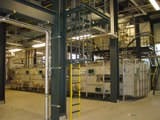Gas-tight Filters Are the Accepted Way to Process Carboxy Methyl Cellulose
The production of carboxy methyl cellulose (CMC) involves an alkali hydrolysis of a cellulosic feedstock followed by carboxylation. This causes the formation of sodium chloride which has to be washed out of the CMC before it can be further processed. Unfortunately this is not so simple, as CMC is soluble in water, so it has to be washed with an alcohol/water mixture usually with a minimum of 60% alcohol. There are three main grades of CMC, technical or crude CMC, purified and food grade. Food grade requires better than 99.8% pure CMC.
Multiple wash stages are required in a counter-current sequence to achieve the varying purity levels.The wash ratios utilized together with the high alcohol content, to stabilize the CMC in the presence of water, require counter current washing to keep the process economically feasible. Traditionally the CMC production was ran on series of up to six centrifuges, set up in counter-current mode but over the last 20 years the Pannevis GT filter has become the equipment of choice as it is possible to carry out from three up to eight or more counter-current wash steps in a single unit under a sealed, re-circulatory nitrogen atmosphere. Pannevis GT filters easily achieve the purity requirements of all three grades, including the food grade.
The Pannevis GT filter offers all the advantages of the standard Pannevis RT filter including the capability to carry out multiple step counter-current washing. The filter housing is normally operated with a slight internal over-pressure using nitrogen, which is continuously re-circulated around the filter circuit so that all components including filtrate receivers and pumps are totally inert. A very small make-up of nitrogen is required to compensate for the gas exiting with the filter cake.





